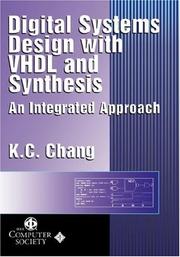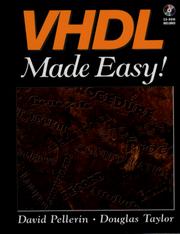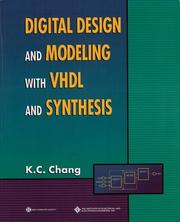| Listing 1 - 4 of 4 |
Sort by
|
Book
Abstract | Keywords | Export | Availability | Bookmark
 Loading...
Loading...Choose an application
- Reference Manager
- EndNote
- RefWorks (Direct export to RefWorks)

ISBN: 0769500234 Year: 1999 Publisher: Washington : IEEE computer society,
Abstract | Keywords | Export | Availability | Bookmark
 Loading...
Loading...Choose an application
- Reference Manager
- EndNote
- RefWorks (Direct export to RefWorks)

ISBN: 0136507638 Year: 1997 Publisher: Upper Saddle River : Prentice Hall.,
Abstract | Keywords | Export | Availability | Bookmark
 Loading...
Loading...Choose an application
- Reference Manager
- EndNote
- RefWorks (Direct export to RefWorks)
1. Introduction. Goals of This Book. What Is VHDL? A Brief History of VHDL. How Is VHDL Used? The FPGA/ASIC Design Process. When Should You Use VHDL? When Should You Not Use VHDL? What About Verilog? What About PLD Languages? 2. A First Look At VHDL. Simple Example- A Comparator. Comparator Source File. Entities and Architectures. Entity Declaration. Architecture Declaration And Body. Data Types. Design Units. Structure Of A Small Design. More Typical Design Description. Levels of Abstraction (Styles). Sample Circuit. Comparator. Shifter (Entity). Concurrent and Sequential VHDL. Signals and Variables. Using a Procedure to Describe Registers. Using a Component to Describe Registers. Structural VHDL. Test Benches. Sample Test Bench. What Weve Learned So Far. 3. Exploring Objects and Data Types. Signals. Variables. Constants. Literals. Types and Subtypes. Scalar Types. Composite Types. Operators. Attributes. Type Conversions and Type Marks. Resolved and Unresolved Types. 4. Using Standard Logic. IEEE Standard 1164. Advantages of IEEE 1164. Using The Standard Logic Package. Std_logic_vector and Std_ulogic_vector. Type Conversion and Standard Logic. Standard Logic Data Types. Standard Logic Operators. Standard Logic Type Conversion Functions. Strength Stripping Functions. Edge Detection Functions. Miscellaneous Checking Functions. Standard 1076.3 (the Numeric Standard). Using Numeric Data Types. Numeric Standard Types- Unsigned and Signed. Numeric Standard Operators. Numeric Array Resize Functions. Numeric Type Conversion Functions. 5. Understanding Concurrent Statements. The Concurrent Area. Concurrent Signal Assignments. Conditional Signal Assignment. Selected Signal Assignment. Conditional vs. Selected Assignment. Procedure Calls. Generate Statements. Concurrent Processes. Component Instantiations. Delay Specifications. Signal Drivers. 6. Understanding Sequential Statements. The Process Statement. Using Processes for Combinational Logic. Using Processes for Registered Logic. Using Processes for State Machines. Specifying State Machine Encodings. Using Processes for Test Stimulus. Sequential Statements in Subprograms. Signal and Variable Assignments. If- Then-Else Statements. Case Statements. Loops. Loop Termination. 7. Creating Modular Designs. Functions and Procedures. Functions. Procedures. Parameter Types. Mapping of Parameters. 8. Partitioning Your Design. Blocks. Guarded Blocks. Packages. Package Bodies. Design Libraries. Package Visibility. Components. Mapping of Ports. Generics. Configurations. 9. Writing Test Benches. A Simple Test Bench. Using Assert Statements. Using Loops and Multiple Processes. Writing Test Vectors. Reading and Writing Files with Text I/O. Reading Non-tabular Data from Files. Creating a Test Language. Youre On Your Way...
681.3*D32 --- 004.436.2 --- VHDL very high speed hardware description language --- digitale elektronica --- elektronica --- elektrotechniek --- ontwerpen --- simulatie --- software --- language classifications: applicative languages; data-flow languages; design languages; extensible languages; macro and assembly languages; nonprocedural languages; specialized application and very high-level languages (Programminglanguages) --- hardware-descriptietaal --- Contains audio-visual material --- VHDL (vhsic hardware description language) --- VHDL (Computer hardware description language) --- Descriptietalen --- VHDL --- VHDL (vhsic hardware description language). --- VHDL (Computer hardware description language). --- Descriptietalen. --- VHDL. --- 681.3*D32 language classifications: applicative languages; data-flow languages; design languages; extensible languages; macro and assembly languages; nonprocedural languages; specialized application and very high-level languages (Programminglanguages) --- Very High Speed Integrated Circuits Hardware Description Language (Computer hardware description language) --- VHSIC Hardware Description Language (Computer hardware description language) --- Computer hardware description languages --- Integrated circuits --- Computer simulation

ISBN: 0818677163 9780818677168 Year: 1997 Publisher: Los Alamitos IEEE Computer Society Press
Abstract | Keywords | Export | Availability | Bookmark
 Loading...
Loading...Choose an application
- Reference Manager
- EndNote
- RefWorks (Direct export to RefWorks)
Descriptietalen. --- Digitale systemen: ontwerp. --- VHDL. --- Very high speed integrated circuits --- VHDL (Computer hardware description language) --- 004.436.2 --- CAD computer aided design --- digitale elektronica --- elektronica --- gegevensverwerking --- modelleren --- ontwerpen --- programmeertalen --- VHDL very high speed hardware description language --- Very High Speed Integrated Circuits Hardware Description Language (Computer hardware description language) --- VHSIC Hardware Description Language (Computer hardware description language) --- Computer hardware description languages --- Integrated circuits --- VHSIC --- Computer-aided design --- hardware-descriptietaal --- Computer simulation --- Very large scale integration
| Listing 1 - 4 of 4 |
Sort by
|

 Search
Search Feedback
Feedback About UniCat
About UniCat  Help
Help News
News